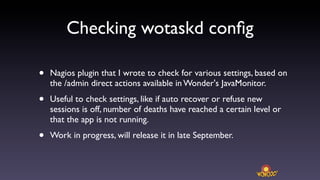Monitoring your WebObjects apps
- 1. Monitoring your WO apps Pascal Robert
- 2. Why monitoring? • Because you want to find out problems before your customers find them! • This is not about finding bugs in your app, more about finding deployment problems. • Have to be notified about any problems, including OS, hardware and Web server problems.
- 3. Nagios • My favorite tool for monitoring. • Been around since 1999 (was called Netsaint back in the days). • Open source (C and PERL code). • Works fine on Linux and OS X (use MacPorts to install on OS X).
- 4. Nagios • Can monitor many things with the default plugins : HTTP, SNMP, disk space, load, etc. • Can do remote checks (checks runs on the "client", essential for things like disk space or load). • Tons of plugins on Nagios Exchange, including for RDMBS like Oracle or MySQL. • Easy to write plugins, be it in PERL, Bash, C or even Java.
- 5. Nagios HTTP check • You can use the default "check_http" plugin. • Will check its state based on content's response, timeout, or HTTP response code (404, 500, etc.) • Can post data (might be useful for REST services). • Can specify a specific HTTP method (HEAD, OPTIONS, TRACE, PUT, DELETE, POST, GET). • Can even check if your SSL certificate is still valid!
- 6. DEMO
- 7. Java-specific checks • Checks with check_http are fine... but won't find some problems like "Out of memory" errors. • You can use JMX for that!
- 8. Java-specific checks • With JMX, you can monitor things like heap memory usage, number of threads, number of loaded classes and CPU usage. • Works fine on Java 5 and 6. • Easy to enable.
- 9. Enabling JMX in your app bash-3.2# cp /System/Library/Frameworks/JavaVM.framework/Versions/1.6.0/Home/lib/management/ jmxremote.password.template /Library/WebObjects/jmxremote.password bash-3.2# chown appserver /Library/WebObjects/jmxremote.password bash-3.2# chmod 600 /Library/WebObjects/jmxremote.password In your apps launch arguments: -Dcom.sun.management.jmxremote.port=XXXX -Dcom.sun.management.jmxremote.authenticate=true -Dcom.sun.management.jmxremote.ssl=false -Dcom.sun.management.jmxremote.password.file=/Library/WebObjects/jmxremote.password
- 10. WO-specific checks • With WO 5.4, the stats available from WOStats are also available by JMX. • It give you access to data like memory usage, average session memory, and average requests per session. • You need to enable JMX + add one line in your Application class constructor.
- 11. JConsole output
- 12. Enabling WO JMX in your app import com.webobjects.appserver.WOStatisticsStore; public Application() { ... registerMBean((Object)statisticsStore(), getJMXDomain(), WOStatisticsStore.class.getName()); }
- 13. check_jmx • check_jmx is a Nagios plugin to connect to JMX-enabled apps. • Written in Java, source code is available. • Sadly, it can only check results of type number or string, no hashmap support.
- 14. DEMO
- 15. Finding EOF deadlocks • Create two DirectActions : one that use EOF, the other pure JDBC. • Make sure the DA returns the same result everytime. • Call the DA with check_http, and validate the result. • If the JDBC check is good, but not the EOF one, good chance that you have a EOF deadlock.
- 16. Checking wotaskd config • Nagios plugin that I wrote to check for various settings, based on the /admin direct actions available in Wonder's JavaMonitor. • Useful to check settings, like if auto recover or refuse new sessions is off, number of deaths have reached a certain level or that the app is not running. • Work in progress, will release it in late September.
- 17. Graphing • Would be nice to graph some data, like memory usage. • Lot of tools can do this (Cacti, SNMP tools, etc.), but you can do it with Nagios too. • Graphing and performance data are useful when stress loading your application with JMeter. • Look at PNP4Nagios or NagiosGraph if you want graphing.
- 19. Resources • Nagios : http://www.nagios.org • JMX : http://download-llnw.oracle.com/javase/1.5.0/docs/guide/management/agent.html • check_jmx : http://exchange.nagios.org/directory/Plugins/Java-Applications-and-Servers/Syabru- Nagios-JMX-Plugin/details
- 20. Q&A Monitoring your WO apps



















